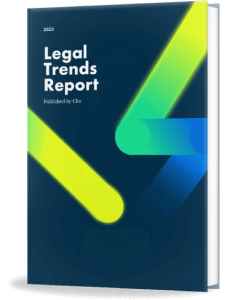Taking stock of your law firm’s finances before year-end is critical for setting up your practice for financial success. By setting aside time at year-end to methodically review your records, close on outstanding receivables, and budget for the year ahead, you’ll give your firm a competitive edge.
You’ll also make planning for the coming year that much easier. Beyond that, gathering necessary firm financial information at year-end streamlines tax time for you and your accountant.
Read on to learn how to get your firm’s year-end financials in shape—so that you’ll be set up for success in the new year.
Did you know Clio has legal accounting software? With Clio Accounting you can connect your bank accounts, manage your firm’s expenses, vendors, and payments, reconcile your trust accounts, produce financial reports, and more!
What are financial statements?
Financial statements are reports that summarize important financial accounting information about your firm.
There are three main components of year-end financial statements:
- The balance sheet: A snapshot of your firm as it stands at a point in time.
- The income statement: Indicates how profitable your firm was over a period of time (i.e., month, quarter, year, etc.)
- The cash flow statement: This statement tells you how much cash entered and left your firm over a particular period.
Combined, these statements provide a holistic overview of the financial position that your law firm is in.
When you know how these statements work (both individually and collectively), you can start seeing all the ways you can optimize your firm’s financial performance.
And, as we mentioned earlier, this comes in handy when you’re preparing year-end financial statements. Let’s explore the steps you can take to ensure that these are in tip-top shape.
1. Identify and collect on outstanding balances

It’s best practice to collect on all accounts receivable promptly. After all, the longer an invoice is outstanding, the less chance you have to collect the full value that your firm earned.
Despite this, the medium amount of revenue that’s uncollected at any given time (referred to as collection lockup) is about 45 days, according to Clio’s 2023 Legal Trends Report. What’s more, 11% of invoices never get paid by clients.
For those clients that are slow to pay, making an effort to close them out in December will make things a lot less messy for your law firm financials the following year.
Step 1: Ensure time entries and bills are current
Before you can look at your collections, it’s important to ensure your firm has been on top of time tracking and billing.
One way to achieve this is to ensure everyone at your firm has tracked their hours through the end of November, so subsequent billing can take place at the beginning of December.
If you’re using the right software, this step should be easy. For example, Clio Manage’s legal time and expense tracking software makes it simple to accurately track hours in real-time, using calendar events, from your inbox, and more—as well as send out bills and organize your law firm financials.
Step 2: Run an accounts receivable report
An accounts receivable report will provide amounts outstanding on all open and past-due invoices.
The accounts receivable tab in Clio allows firms to sort the unpaid or partially paid balances by client, due date, or balance owed. This ability to see AR aging status allows firms to improve cash flow more efficiently and effectively.
Step 3: Identify large and/or old outstanding balances
Because your chances of collection decrease with time, it’s also a good idea to identify long-overdue balances before the end of the year.
Why? As Saville’s David Epperson explains in his year-end law firm financials checklist, this leads to another important year-end action: “For any accounts deemed uncollectible, write them off as of December 31.”
You can see any overdue balances in Clio under Outstanding Balances (located within the main Billing tab of Clio Manage) and easily send payment reminders by email to clients. In Clio Accounting, you can track all invoices, payments, and expenses at a glance, with information sharing between Clio Accounting and Clio Manage. This helps you keep a real-time view of your firm’s financial standing, including all outstanding payments.
Taking this step can boost your bottom line: The 2023 Legal Trends Report found that law firms that use the outstanding balances summary had collection rates that were 5% higher than firms that weren’t using it.
Step 4: Collect!
If you have several unpaid accounts, December can be a tough month to do collections—clients are focused on the holidays and are spending money on gifts, travel, and festivities. Again, it’s best practice to stay on top of your collections all year round—but it’s not always possible to keep up.
However, there are a couple of positive reasons to collect in December:
- Bonuses = extra funds to pay invoices. Many companies give out bonuses during the holidays. Which means your client may have an additional source of revenue in December to pay your invoice.
- It’s everyone’s year-end. If you represent businesses, they’re usually looking to pay all their expenses before year-end. It’s best to send bills early in December so your clients can get on top of payments.
Be sure to check out our accounting for lawyers hub for more resources.
Tips for improving your year-end collections process
Still stuck on how to smooth the collections process? Try these collections tips as you sort out your year-end financials:
- Offer a discount. Consider giving a small discount for bills paid before year-end to encourage clients to pay you sooner.
- Be clear and prompt when billing. There are many reasons why a bill may be going unpaid—be sure that you’re not one of them. Clio’s legal billing software makes it easy to generate clear, readable bills quickly, with customized, branded templates, so you can send professional bills out on time. And, if you do so electronically with Clio, billing and collections are simpler and faster than ever before. You can see all of this in action by scheduling a demo.
- Bill more frequently. Try billing every two weeks in December instead of monthly, explaining the change in your billing process with a letter. Again, most clients will understand that you’re simply being proactive and working on getting your law firm’s year-end financials in order.
- Send reminders. Your clients may not be holding off intentionally. Send a brief reminder to ensure your firm is top of mind (you can do this under Outstanding Balances in Clio).
- Start accepting online credit card payments. When you make it easier for clients to pay, you’re more likely to get paid (and get paid faster). According to the 2023 Legal Trends Report, credit card payments are the top preferred option among clients for paying a lawyer. So not surprisingly, law firms that use online payments like these get paid more than twice as fast compared to those that don’t—with a median waiting period of just seven days.
- Set up a payment plan. If your clients are unable to pay on time, consider setting up a payment plan to get them back on track, and collect what you’re owed within a mutually agreeable time-frame. Survey data from the 2023 Legal Trends Report found that law firms using payment plans collected 49% more monthly revenue per lawyer than firms that didn’t.
Note: If you feel a bit lost when it comes to accounting specifics and want to review the essentials for legal professionals, check out these accounting and bookkeeping best practices for law firms, featuring advice from Clio Cloud Conference speaker Amanda Aguillard, CPA.
2. Review your trust accounts

You may be meticulous all throughout the year when dealing with your law firm’s trust accounts (which you should be, in order to stay compliant). Even so, you should dedicate time as you prepare your year-end financials to double-check that you’ve been diligent about moving money from your trust account to your operating account as fees were earned. Here’s how:
Ensure all of your client ledgers are balanced
Check that client ledgers are balanced by running a Work in Progress (WIP) report to look for any outstanding time or expenses.
Did you find anything outstanding? If so, invoice yourself, and pay yourself out of your trust accounts before year-end.
Reconcile your trust accounts before year-end
Next, you’ll also need to reconcile your trust accounts before December 31. That means checking your records against your bank statements to make sure that everything lines up.
In many states, lawyers are required to do this each month, but some states also require annual reports—so, check what’s required in your area.
Use tech to simplify the process
By removing some of the manual work of managing trust accounting, you reduce the risk of error—which is why technology can simplify the process of checking and reconciling trust accounts at year-end.
- Tools like Clio Manage’s trust accounting software make it easier to keep accurate records of trust funds and transactions—so you can stay compliant and be confident at the end of the year.
- With Clio Accounting you can connect your bank feeds and conduct three-way trust reconciliation–helping you stay compliant and making year-end reconciliation simpler.
- Accounting tools like QuickBooks or Xero help manage your accounting and recordkeeping year-round, and they integrate with Clio Manage.
3. Review your law firm financials

The key to setting yourself up for success in the new year is to clearly see how you’ve done this year by properly tracking your law firm’s financials.
Review your law firm’s financial statements, including:
Actual prior year revenue/expenses:
- Were you in the red or black LAST year (and by how much)?
Current year revenue/expenses:
- Were you in the red or in the black THIS year (and by how much)?
Actual current year cash flow by month:
- How did you do in terms of cash flow on a month-to-month basis?
Current year-to-date (YTD) actual compared to YTD budget:
- Compare your current year-to-date revenue/expense to your year-to-date budget for the year.
- Don’t have a law firm budget? This is a great time to make one for next year!
Opening and ending operating account balance:
- Look at your account balances on a year-to-year and month-to-month basis.
- How is your cash flow?
- Do you need to be more mindful of when expenses come up?
Profit/loss by month (which is different than the operating account balance):
- This is similar to the first two items on this list, but it isn’t quite the same: You’ll be looking at your bottom line each month, which is your revenues and gains minus your expenses and losses.
- Look for any telling trends month-to-month.
- For example, November might always be a slower month, and March might always be busy.
- For most lawyers, profit/loss will still be fairly similar to your revenue/expenses, but if you’ve made a big investment in technology or hardware for your firm, it’s worth taking a look at this number too.
Accounts receivable each month:
- How much were you owed each month? You’ll be able to see this under your accounts receivable report.
A cash flow projection
In addition to looking back on the past year, and forward into the future, you’ll also want to examine where you’ll be for the rest of the year with a cash flow projection. A cash flow projection can help estimate your firm’s cash on hand as of December 31. This should account for items such as:
- December operating expenses
- Staff bonuses
- Quarterly tax payments
- Paying down a firm line of credit
- Profit distributions to equity partners
Putting it all together
Once you’ve got a bird’s-eye view of your law firm’s financials, here’s what to look for:
- Compare your current year’s revenue to last year’s revenue and your current year’s budget. This keeps you aware of areas where you may be overspending, underperforming, or doing great.
- Look at the opening and ending balance of your operating account, and look for yearly trends or patterns to see if you are starting the month out with less in the bank than you thought you would be.
- Look at your total accounts receivable, and keep an eye on whether this number is growing month-to-month. If it is, you need to be more diligent with your collections!
4. Get ready for tax season

Tax season can sneak up on you faster than you think. To make sure you’re prepared (and that you’ve taken advantage of all available tax deductions), take these steps at year-end:
- Look at your “Owner’s Draw” account. Make sure the entries in this account are correct (these are expenses you ran through the business as non-business-related expenses).
- Clear the receipts. Clean out the pile of receipts in your drawer/purse/wallet/car and make sure you have properly reimbursed yourself for any business-related expenses you paid on your personal credit cards or from your personal checking account.
- Check travel expenses. Review your calendar for appointments and places you’ve traveled that were business related and make sure you have prepared expense reports for mileage.
- Consider tax-deductible expenses. If you’re running your business using the cash method of accounting in the US, invest in tax-deductible expenses to offset this past year’s revenues. For example, consider purchasing a yearly subscription to Clio Manage and other services you might need to save come tax time, such as Clio Grow or Clio Draft.
- Ensure you’re paid up. Now is also a good time to check that you’re up to date with your tax obligations for the current year. For example, have you met and paid any quarterly tax payment obligations?
- Law Firm Financials key takeaways: Review, reconcile, record.
5. Consider hiring a law firm accounting professional

Organizing your law firm financials can be an overwhelming and time-consuming process—especially at the end of the year when your firm is wrapping things up for the year.
By hiring a law firm accounting professional, especially a CPA (Certified Public Accountant), you will have more time to focus on other aspects of your law firm, and can rest easy knowing the details are taken care of.
In addition, an experienced accountant is also an expert in helping your firm’s financials, tax planning, tax compliance, and more. For the best outcomes, we suggest working with accountants who specialize in working with law firms. Try asking fellow attorneys for recommendations, or check with your State Bar or any accountant referrals.
You can also find the right accounting professional by checking out our Clio Certified Consultants.
You’re ready to get your year-end law firm financials in order
The truth is, there’s no need to be afraid when it comes to organizing year-end law firm financials. If you’re following best practices for law firm accounting and using the right tools to help year-round, then end-of-year is just a matter of reviewing your firm’s finances and making sure everything is in order before December 31.
To review, below are our top tips for preparing your firm’s year-end financials:
- Review your accounts receivable. Ensure your billing is up to date, and collect on outstanding accounts.
- Review your trust accounts. Invoice and pay yourself for any outstanding amounts, reconcile your trust accounts, and report any unassigned fees if necessary.
- Check in on your performance. Look at how you’ve done for the year in terms of revenue compared to your budget, and compared to last year’s revenue, to get an idea of your firm’s performance. Then, set goals and make them part of your business plan for the coming year.
- Get your records in order. Look through your receipts and make sure you’ve reimbursed yourself for business expenses by year-end. You’ll thank yourself come tax time!
- Consider hiring a law firm accountant. An experienced CPA can help with your law firm’s financial strategy, tax planning, tax compliance, and more.
Get your firm’s financials in order for the year, and you’ll be that much more prepared to grow your law firm and enjoy more success in the year to come.
Want more on legal accounting for lawyers? Check out our Accounting for Lawyers resource hub, full of articles and guides. And if you’re ready to have your case management tool and accounting tool in one place, book a demo of Clio Accounting to see how it works with Clio Manage. Set your firm up for financial success in the new year!”
Note: The information in this article applies only to U.S. practices. This post is provided for informational purposes only. It does not constitute legal, business, or tax advice.


